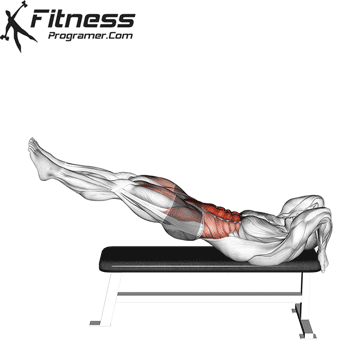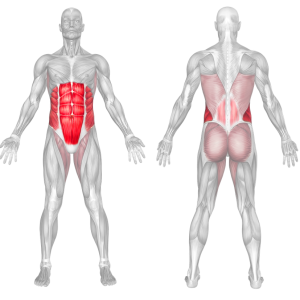Dragon Flag
The Dragon Flag is a challenging exercise that offers a wide range of benefits, particularly for your core muscles. To perform Dragon Flags correctly, you need precise control over your body’s movement, both during the lowering and raising phases.
This includes controlling the lowering (eccentric) phase and raising (concentric) phase of the exercise. Maintaining stability throughout the exercise showcases your mastery of control and coordination, which is a key element of advanced calisthenics.
Dragon flag is a challenging exercise, strong core muscles and good muscle coordination are required to perform this exercise, so it is not recommended for beginners.
How to do:

- Set Up: Lie flat on your back on a sturdy bench or a flat surface. Ensure your head is supported, either by holding onto the bench or using a neck cushion. Place your hands firmly on the bench or hold onto a stable surface above your head.
- Leg Raise: Lift your legs and hips off the bench or ground, keeping them straight. Your body should form a straight line from your head to your feet. Engage your core muscles to stabilize your body.
- Controlled Descent: Slowly lower your legs and hips towards the bench while maintaining a straight body line. Focus on using your abdominal muscles to control the movement. This is the most challenging part of the exercise, so take your time.
- Raise Your Flag: Once your legs are close to the bench or ground (but not touching), reverse the movement by using your core strength to raise your legs and hips back up to the starting position.
- Repeat: Perform the exercise for your desired number of repetitions.
Form Tips and Common Mistakes to Avoid
- Keep your arms and hands firmly planted to maintain stability.
- Focus on controlled movements; avoid swinging or using momentum.
- Maintain a straight body line throughout the exercise.
- Breathe steadily and avoid holding your breath.
- If you experience neck discomfort, consider using a cushion or towel for support.
Benefits Of Dragon Flag
Core Strength: The primary benefit of the Dragon Flag is its ability to strengthen the core muscles. It targets the rectus abdominis (front of the abdominal muscles), obliques (side abdominal muscles), and even engages the lower back muscles. This results in a stronger and more stable core.
Six-Pack Development: If you’re aiming for a well-defined six-pack, Dragon Flags can help you achieve that goal. The exercise specifically targets the abdominal muscles, contributing to a more chiseled appearance.
Isometric Strength: In addition to the dynamic aspects of the Dragon Flag, there’s an isometric component as you hold your body straight and stable during the exercise. This requires continuous engagement of your core muscles to prevent your body from sagging or swaying. Your ability to maintain this isometric contraction further underscores your mastery of bodyweight control.
Impressive Visual Display: Beyond the physical benefits, Dragon Flags are visually impressive. Successfully executing this exercise showcases your physical abilities and dedication to your fitness regimen, often earning respect from fellow fitness enthusiasts.
Dragon Flag Muscles Worked
Target Core Muscles: ▪ Rectus Abdominis ▪ Transverse abdominis ▪ Obliques ▪ Multifidus ▪ Pelvic floor ▪ Quadratus lumborum ▪ Erector Spinae

